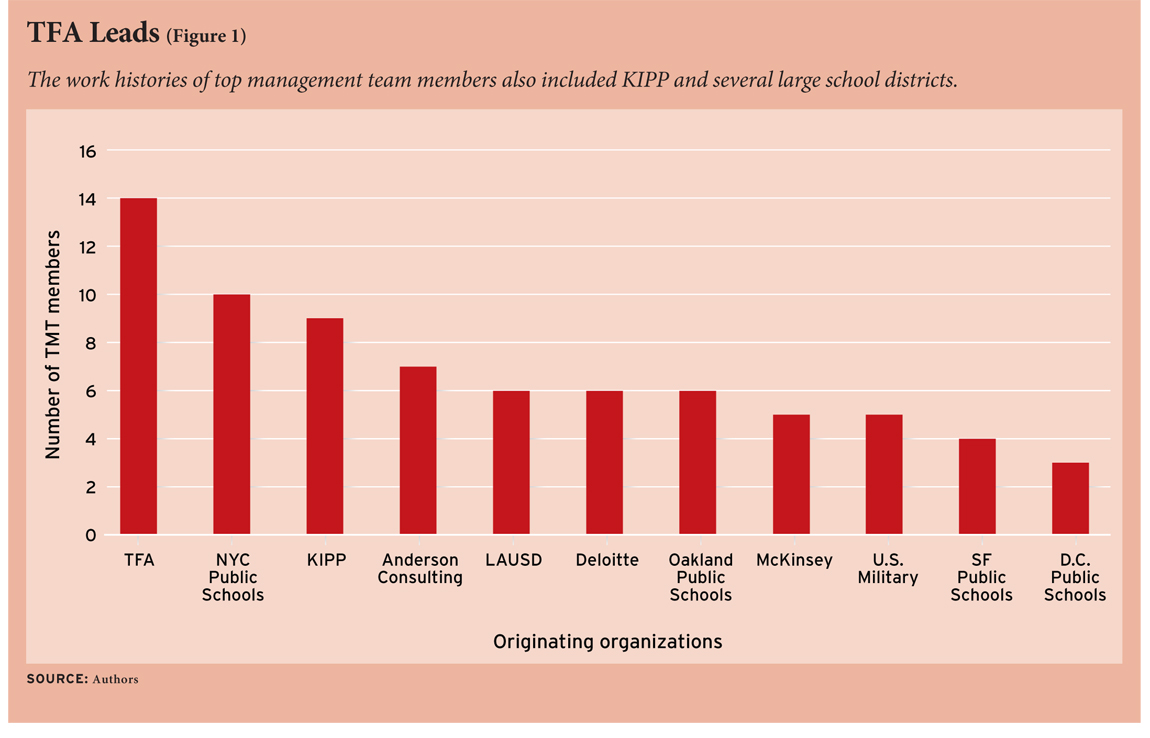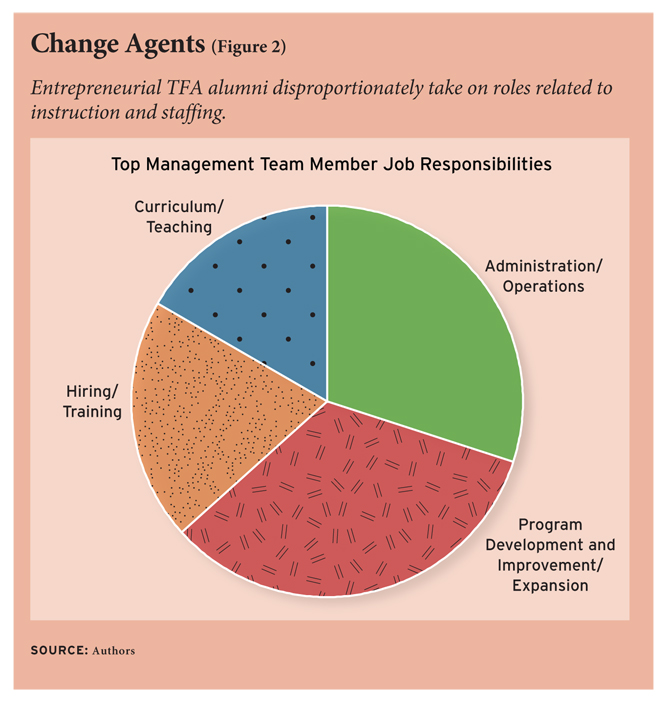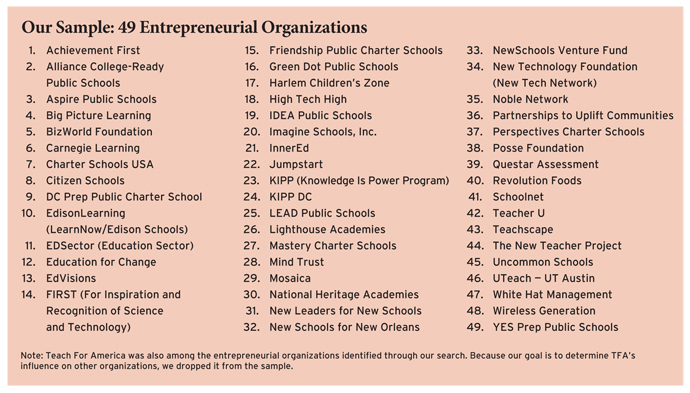 Question: What do former D.C. Public Schools chancellor Michelle Rhee, KIPP Academy cofounders Mike Feinberg and David Levin, and Colorado state senator (and author of that state’s nationally noted teacher-quality legislation) Mike Johnston have in common? Answer: They’re all alumni of Teach For America.
Question: What do former D.C. Public Schools chancellor Michelle Rhee, KIPP Academy cofounders Mike Feinberg and David Levin, and Colorado state senator (and author of that state’s nationally noted teacher-quality legislation) Mike Johnston have in common? Answer: They’re all alumni of Teach For America.
While much of the debate around Teach For America (TFA) in recent years has focused on the effectiveness of its nontraditional recruits in the classroom, the real story is the degree to which TFA has succeeded in producing dynamic, impassioned, and entrepreneurial education leaders. From its inception as Wendy Kopp’s senior thesis project at Princeton more than two decades ago, TFA has sought to bring more teaching talent to some of the nation’s most disadvantaged communities and create a corps of change agents like Rhee, Feinberg, Levin, and Johnston. How well has TFA fared on that second score? Here, in a new line of research, we seek to answer that question.
Since its founding in 1989, TFA has placed more than 24,000 high-achieving college graduates in some of America’s neediest schools. This has produced an alumni network populated by impassioned former educators. TFA aims, proclaims the web site, to turn these alumni into “lifelong leaders for fundamental change, regardless of their professional sector.” Its efforts include keeping close connections with alumni and providing a variety of opportunities to volunteer at schools, join education-oriented political campaigns, advocate, and connect with a wide-reaching education network.
To date, the vast majority of research on TFA has focused on the classroom effectiveness of corps members and how long they remain in classrooms. Very little is known about TFA corps members who leave teaching but stay involved in education reform more broadly. In a recent study of TFA alumni, Doug McAdam and Cynthia Brandt (2009) argue that corps members are more likely to remain in education, whether in administration, educational policy work, or charter school management, than those who opt not to enter TFA or drop out of the program. This suggests that TFA has a lasting influence on corps members’ careers, but does not address the question of whether these individuals become the kind of change agents envisioned in TFA’s mission of eliminating “educational inequity by enlisting our nation’s most promising future leaders.”
We pursue that question here, as part of a larger analysis of organizations that successfully “spawn” education entrepreneurs. Examining the work histories of founders and top management team (TMT) members at nationally prominent entrepreneurial education organizations, we find that TFA appears more frequently in the professional backgrounds of these proven entrepreneurial leaders than does any other source in our sample. We don’t know whether it is the TFA experience, the criteria by which TFA selects its corps members, or institutional relationships that account for this. However, the research does find that TFA is producing a large number of entrepreneurial leaders. How and why this is so, and what might be learned from TFA’s success, are questions that deserve careful scrutiny.
Entrepreneurs Needed
The education sector has long struggled to attract and retain high-quality professionals. At the same time, stubborn achievement gaps, increased competition among school providers, and a heightened focus on performance have created an appetite for creative problem solving and scalable, transformational initiatives. In a world of online learning, school turnarounds, Race to the Top, and the Investing in Innovation Fund, there is room for leaders who are able to lever change by creating and expanding organizations of all kinds. Turning these opportunities into results requires people able to create and lead new, high-quality ventures.
With the proliferation of teacher residency and principal leadership programs, education has seen many efforts to recruit, develop, and retain quality teachers and administrators in recent years. However, there are fewer organizations aimed at developing leaders to direct reform initiatives outside the classroom or the schoolhouse. TFA is one among a small cadre of organizations that currently includes New Leaders for New Schools, Education Pioneers, and Teach Plus. TFA is particularly notable for its efforts on this score, as it engages former corps members through “Alumni Summits” and initiatives to advance alumni in positions of leadership as nonprofit board members, public officials, and leaders at the school and classroom level. It also supports alumni through partnerships with graduate schools and employers to help them transition to the next steps in their careers.
Recently, TFA started a new program, the Social Entrepreneurship Initiative, which explicitly promotes innovation and entrepreneurship in the education sector. The program facilitates connections between alumni interested in starting education ventures with established social entrepreneurs. The initiative supports TFA alumni who are applying for fellowships such as Echoing Green and the Mind Trust, provides tools for developing fundraising plans and grant proposals, and publishes a newsletter that includes information about funding opportunities and management strategies.
Today, there is a sizable network of TFA alumni who have become education entrepreneurs. We have already mentioned KIPP Academy cofounders Mike Feinberg and Dave Levin, who started a single charter school in 1994 that has evolved into one of the most well-known charter organizations in the U.S., with 99 schools in 19 states and the District of Columbia. TFA alum Chris Barbic founded YES Prep Public Schools, which has grown to serve 4,200 students at eight campuses throughout Houston. Sarah Usdin began New Schools for New Orleans (NSNO) in 2006, after Hurricane Katrina devastated public schooling in that city. Before heading up the D.C. school system, Michelle Rhee established The New Teacher Project. Accounts sometimes suggest that these individuals are intriguing outliers. Our research suggests that they are evidence of TFA’s success at recruiting and creating change agents.
Research Methods
The methods used in this study mirror those applied in research on entrepreneurial spawning in other sectors, such as biotechnology. We first identified a group of entrepreneurial organizations within the education sector and traced their founders’ and TMT members’ work histories. We then identified organizations that appeared multiple times as previous employers across the sample and, hence, could be considered “spawners” of entrepreneurial leaders.
To create our list of entrepreneurial education organizations, we limited our search to nonprofit and for-profit organizations that were founded after 1989, TFA’s inaugural year; that focused on domestic, K–12 public education reform; and that could be considered nationally prominent. We drew on three distinct sources to identify organizations for our sample. The first was an electronic survey of 14 widely recognized experts in public school innovation. We asked participants, “From your perspective, what are the top 15 U.S. entrepreneurial education organizations that have emerged in the sector since 1989?” All 14 participants responded, and we identified 16 organizations that more than one respondent identified as a top organization. Next, we identified organizations supported by a donor clearinghouse of venture philanthropies and foundations whose mission is to support social entrepreneurship in K–12 public education across the nation. Finally, we conducted publication searches in popular and academic media using Lexis Nexus and Google Scholar. The searches were conducted in November 2009 and used the following search terms: Education, Entrepreneur*, Organization, and K–12.
These methods yielded a comprehensive list of 49 organizations; many are charter management organizations, some recruit and/or train human capital, and others offer supplemental resources to the public education sector, such as software technologies for data management and assessment or afterschool programs (see sidebar).
We then constructed a database of the work histories of the 49 organizations’ leadership members, comprising 71 founders and cofounders and 320 TMT members. We make the distinction between founders and other management team members in the event that there are noteworthy differences between those who start organizations and those hired to manage daily functioning, growth, and stability. Often, the organizations in our sample publicly listed the founders and members of the management team, along with their work and educational histories. When these data were ambiguous or not publicly available, we called the organizations to request the information.
We term the organizations that appear in founders’ and TMT members’ work histories “originating organizations.” To ascertain which originating organizations were the most prolific spawners of entrepreneurs, we identified those that had at one time employed a founding member of at least 2 of the 49 entrepreneurial organizations in our sample.
Entrepreneurship and TFA
Of all the originating organizations that appeared in work histories, TFA appeared the most frequently. Let’s look first at the 71 founders or cofounders of the 49 entrepreneurial organizations. TFA appeared in the work history of at least one founder of seven of these organizations, or about 15 percent. The next most-represented originating organizations—the San Francisco Public Schools, Newark Public Schools, Chicago Public Schools, AmeriCorps, the White House Fellows program, McKinsey & Company, and the United States Department of Education—each appeared in the work history of a founder of two (or about 4 percent) of these organizations. In other words, the drop-off from TFA to these other large and/or esteemed organizations is stark indeed.
To get a sense of whether TFA’s outsized success is simply the result of its size or TFA is indeed punching “above its weight,” it’s worth noting the comparative size of these various ventures. TFA is today an organization with almost 10,000 employees, including 8,200 current corps members. But TFA’s size a decade ago was only about one-quarter of what it is today, meaning that the alumni pipeline is much thinner than its current size suggests. TFA estimates that it has produced more than 20,000 alumni. TFA is clearly smaller than organizations like the Chicago Public Schools, with around 41,000 employees, and McKinsey, with some 17,000 employees. TFA is dwarfed by the approximately 75,000 current AmeriCorps members and some 500,000 alumni (some AmeriCorps volunteers are also TFA corps members), but is far larger than the White House Fellows program, with 13 current fellows and some 600 alumni. In short, TFA has fared impressively for its relative size.
While many founders have participated in TFA, there is little evidence of their having had other work or internship experiences in common. One reason for this homogeneity may be that approximately 23 percent of the founders had only one job prior to starting their own venture. A lack of experience created fewer opportunities to build professional networks, making the large number of TFA alumni among founders all the more salient.
 TFA stands out in the work histories of the TMT members at the 49 organizations on our list as well (see Figure 1). Fourteen of the 49 entrepreneurial organizations had at least one TMT member who was once a TFA corps member or employee, and 10 of these organizations had at least one member who had been a TFA corps member and worked for TFA national. Compare this to the next three highest-ranked originating organizations: 10 entrepreneurial organizations had at least one TMT member who had been employed by the New York City Public Schools, nine entrepreneurial organizations employed KIPP alumni, and the work histories of seven entrepreneurial organizations’ TMT members included Andersen Consulting.
TFA stands out in the work histories of the TMT members at the 49 organizations on our list as well (see Figure 1). Fourteen of the 49 entrepreneurial organizations had at least one TMT member who was once a TFA corps member or employee, and 10 of these organizations had at least one member who had been a TFA corps member and worked for TFA national. Compare this to the next three highest-ranked originating organizations: 10 entrepreneurial organizations had at least one TMT member who had been employed by the New York City Public Schools, nine entrepreneurial organizations employed KIPP alumni, and the work histories of seven entrepreneurial organizations’ TMT members included Andersen Consulting.
A Look at the Spawners
Only two of the originating organizations that spawned at least two founders, the White House Fellows program and McKinsey & Company, operate outside the public education sector. McKinsey, a management consulting firm, is the only private institution on the list. When it came to spawning TMT members, McKinsey was joined by its consulting brethren Andersen and Deloitte. For TMT members, consulting was a common professional experience with about 10 percent of all TMT members having this practice in their backgrounds.
It is interesting to consider why experience in the consulting industry is not unusual in the career histories of TMT members. Members of top management teams, including chief finance officers, chief operating officers, and even those leading growth and marketing divisions, face complex challenges. Consultants are commonly hired to solve problems in these functional units in both the private and public sectors. Perhaps their skills translate well in the entrepreneurial world. Former consultants may be particularly adept at addressing tough management issues in entrepreneurial organizations in the education sector, where challenges arise both internally and externally, due to the complicated political and financial dynamics of meeting public education needs in the U.S. There may be certain functional roles on TMTs for which having a consulting background prepares leaders particularly well.
Additionally, consulting firms such as McKinsey are increasingly offering their services in the education sector. For example, McKinsey’s Social Sector Office supports an education practice that focuses on systems strategy and transformation, talent and performance management, administration and operations, and institutional strategy and innovations. Teams in McKinsey’s education practice regularly publish reports on the education sector, including a recent analysis of the economic impact of the achievement gap and strategies for attracting top undergraduates to and retaining them in the teaching profession. Such work may be exposing their employees to the overwhelming need in the education sector for solutions to challenging problems. That exposure, coupled with entrepreneurial aspects of the organizational culture, employee selection criteria, or institutional relationships may create an environment similar to TFA. Again, we cannot be sure at this stage what factors may be at play, but it is certainly an intriguing finding.
Another leading spawner of team members is KIPP. Nine organizations in the sample had at least one TMT member who had worked for KIPP’s national office or in a KIPP school. Given that KIPP was started by two TFA alumni, maintains close ties with TFA, and recruits many of its teachers from the TFA ranks, it is no surprise that five organizations in the sample had TMT members who had previously worked both for TFA and for KIPP.
Several school districts were also among the organizations that showed up most often in TMT members’ work histories. New York City appeared most often. Other districts were Washington, D.C., San Francisco, Oakland, and Los Angeles.
Looking across all the spawning organizations, one returns to the question of why, given the many sources feeding into the education talent pipeline, TFA seems so prolific. It seems clear that explanatory factors include the criteria by which TFA recruits, the organization’s strong and purposive culture, the skills that corps members develop, and the opportunities provided to alumni. Just to take one example, by providing talented young college grads with classroom experience, TFA confers upon them a degree of credibility that opens doors that might open less readily for others. Sorting out the relevant import of these elements is far beyond the scope of our current effort, but it is an exercise well worth pursuing for those reformers eager to identify, emulate, and amplify TFA’s successes.
TFA’s Influence
Is there cause to suspect that there are any systematic differences between those education entrepreneurs who are TFA alumni and those who are not? Given their classroom experience, for instance, are TFA alumni more likely to wind up in instructional or curricular roles than are TMT members who are not TFA alumni?
 To investigate this possibility, we looked at the 30 TFA alumni who are TMT members at organizations in our sample and identified the specific nature of their jobs. As seen in Figure 2, less than one-third of these TFA alumni are in administrative positions like operations or finance. Most are involved in human resources, such as hiring and training teachers or other support staff; academic affairs, such as developing curriculum for instructional programs or schools; or working to develop new schools or expand existing ones. This first cut suggests that entrepreneurial TFA alumni disproportionately take on roles more closely related to instruction and staffing. As mentioned earlier, it is not uncommon for TMT members in operations and finance to have consulting experience in their professional backgrounds.
To investigate this possibility, we looked at the 30 TFA alumni who are TMT members at organizations in our sample and identified the specific nature of their jobs. As seen in Figure 2, less than one-third of these TFA alumni are in administrative positions like operations or finance. Most are involved in human resources, such as hiring and training teachers or other support staff; academic affairs, such as developing curriculum for instructional programs or schools; or working to develop new schools or expand existing ones. This first cut suggests that entrepreneurial TFA alumni disproportionately take on roles more closely related to instruction and staffing. As mentioned earlier, it is not uncommon for TMT members in operations and finance to have consulting experience in their professional backgrounds.
Looking Ahead
The findings presented here on the leadership pipeline signal many avenues for productive future inquiry. First, TFA specifically sets out to recruit individuals with leadership potential. As TFA explains, it seeks college graduates who have demonstrated “past leadership and achievement…perseverance and sustained focus in the face of challenges, strong critical thinking skills…[an ability to generate] relevant solutions to problems, superior organizational ability…and superior interpersonal skills to motivate and lead others.” The TFA selection process consists of an online application, a phone interview, and a final interview, which includes multiple individual and group activities, plus a personal interview. Sorting out the impact of TFA acculturation and training from its success as a talent identifier will require additional research that examines the alumni’s career expectations and decisions over time, with an eye to their experiences during and after their corps engagement with TFA.
Second, we found that certain of TFA’s geographic regions appeared more likely to generate entrepreneurial behavior. TFA corps members with work experience in New York City and San Francisco seemed especially likely to become top managers in entrepreneurial organizations in education. Perhaps there is something distinctive about the TFA experience in these locales. Maybe, and more likely, there was something about the place at that particular time that worked in concert with the TFA experience to produce entrepreneurial leaders in a particularly effective way.
In the 1990s, when many of the entrepreneurial organizations in our list were being founded, San Francisco, and the Silicon Valley more generally, was a hotbed of entrepreneurial behavior, which included unprecedented levels of capital funding for those wanting to start their own ventures. At the same time, New York City, with its similar culture of entrepreneurialism and capital funding activity, was going through a period of political and educational reform that would lead to the era of mayoral control. This period of fl ux created opportunities for new organizations and programs to enter the education market. The combination of an entrepreneurial culture, access to funding, and openings within the education market may have made these cities particularly conducive to TFA’s mission of creating entrepreneurial leaders; indeed, the two cities were among the first to bring TFA teachers into their schools. Therefore, it may be useful to think about the TFA experience more expansively and with an eye to its place within a larger context of reform and opportunity.
Third, working for TFA at the national level appears to be a more common experience for those who end up working for an entrepreneurial organization, rather than founding one; TFA members who were founders of organizations were more likely to have been TFA corps members. This suggests that different TFA experiences may equip alumni for different roles. It raises a variety of important questions, most notably, what it is about the TFA experience that imparts to individuals the skills and desire to tackle certain challenges.
Certain kinds of organizations, such as TFA and KIPP, and professions like consulting may be especially conducive to producing educational entrepreneurs. It is worth asking whether there are particular jobs, roles, or work environments that contribute to the cultivation of entrepreneurial behavior.
Finally, our research suggests the value of rethinking how TFA and its alumni have been studied in education and also how we think about retention. Rather than assume that it is good or bad when TFA members leave classrooms or school systems, we focused on the role that TFA alumni may play in launching entrepreneurial ventures. While TFA members may not be retained as teachers, the findings suggest they may still have an impact in education, perhaps an outsized impact.
Another intriguing question is how to weigh the impact of a single Mike Feinberg, Mike Johnston, or Michelle Rhee. Is their impact equal to that of having 100 teachers stay another year? Of 1,000 teachers staying another five years? Is it worth having thousands frequently depart classrooms if it increases the likelihood that a single game-changing entrepreneur—a Steve Jobs or a Bill Gates—will emerge? Conventional debates about retention and TFA teacher effects may start to seem trivial when we compare the potentially enormous impact of a few such individuals.
Monica Higgins is professor of education at the Harvard Graduate School of Education and author of Career Imprints: Creating Leaders Across an Industry. Frederick Hess is an executive editor of Education Next and author or editor of several books, including Education Unbound and Educational Entrepreneurship. Jennie Weiner and Wendy Robison are doctoral students in Education Policy, Leadership, and Instructional Practice at the Harvard Graduate School of Education.




